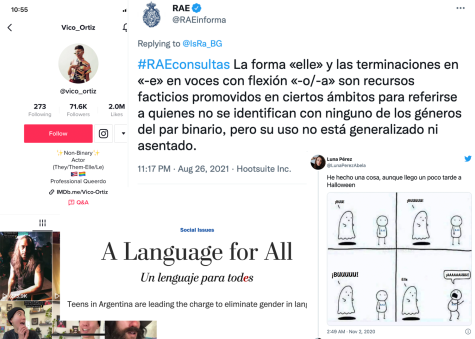Beyond the binary: a third pronoun in French and Spanish classes
In recent years, French and Spanish languages have shifted in favor of the inclusion of non-binary pronouns and by extension, people. “If 25 years ago someone had said, ‘my pronoun is they,’ no one would have understood what that meant,” said French Teacher and Language Department Chair Arnaud Finet. This change in language has been especially difficult in French and Spanish, both of which are taught at Urban.
The pronouns most often taught in Spanish classes are él and ella. Use of the nonbinary pronoun elle has recently come into practice. When speaking in Spanish, the concordance of a noun must agree with the gender of the person to whom the noun is being attributed. For él, the noun ends in -o, for ella the noun ends in -a, and for elle noun ends in -e.![]()

La Real Academia Española is the institution that officially dictates the grammatical rules and word usage in the Spanish language. Their mission statement states, “[Our] main mission is to ensure that the changes experienced by the Spanish language … do not break the essential unity that [the language] maintains throughout the Hispanic sphere.” In spite of protests and social media movements across Latin America for the use of more inclusive language, La Real Academia Española has not yet recognized the use of elle and nonbinary conjugations in Spanish.
While elle and il are the female and male pronouns taught in French classrooms, in the past five to ten years, the nonbinary pronoun iel has emerged. The pronoun iel was added to the widely known French dictionary “Le Robert,” leading to pushback from conservative groups and excitement from others who felt their identities were finally being officially recognized. After this addition, Jean-Michel Blanquer, the minister for national education in France, tweeted: “Inclusive writing is not the future of the French language.”
Finet believes the pushback is due to how new the pronoun is. “It’s changing,” said Finet. “French people don’t like to change very much.”
For GSA co-leader Orrie Rindal ‘22, Spanish was the only class she took where introductions included just names and not pronouns. Rindal believes that it would be helpful to inform students about nonbinary pronouns. “It creates a safer environment and adds a sense of comfort to know that it’s there,” she said.
GSA co-leader Naya Woods ‘24 agrees. “I’m grateful for the faculty who have gone the extra mile to convince other faculty to support their students,” she said. “I personally have seen a lot of avoidance of different pronouns because [teachers] don’t want to complicate things or make things different.”
Urban Spanish teacher, Raina Mast, first encountered a student who uses nonbinary pronouns over six years ago. At the time the student was taking Spanish, they did not have access to elle, and were asked to choose between using él and ella. By the end of their time at Urban, elle was still not widely used or accepted. Mast said, “[This experience] showed the need for the Spanish language to come up with a pronoun.”
Urban’s French department has also introduced inclusive language in some classrooms, but there are still strides to be taken. Amelia Hayward ‘23 said, “We could definitely be introduced to it at least in 1A when you’re introduced to all the pronouns. [Iel] doesn’t change the conjugation in French and if it doesn’t change how you conjugate then we should be introduced to it.”
Finet, through talking to relatives in France, says that many French schools are all-inclusive. “It’s widely accepted that the person who goes by iel can actually choose which [pronoun] they want to identify with,” he said.
“The reason I teach Spanish is to connect with people… part of creating those connections is being able to speak to someone with the name and with the pronouns that they are,” Mast said. “Otherwise, you’re missing the whole point.”











